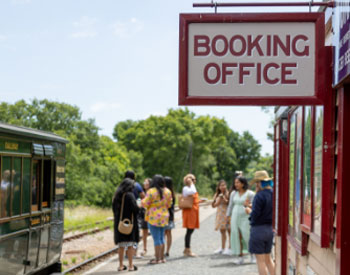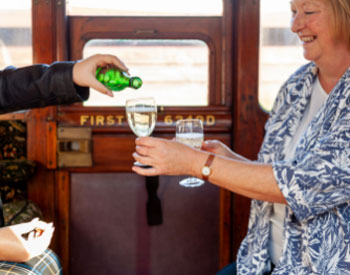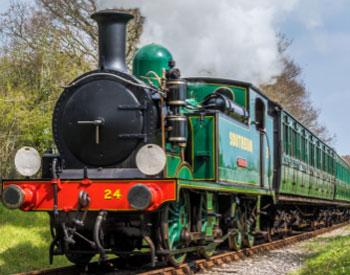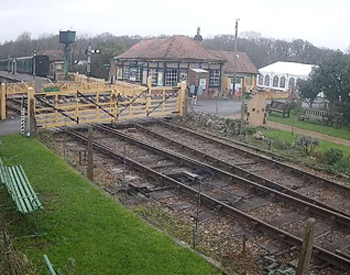Home » Heritage » Our Rolling Stock » Historic Carriages » Grounded Bodies
At a number of locations around the Isle of Wight the grounded bodies of historic railway carriages can still be seen. Some sit in fields serving as farm outbuildings, others have been incorporated into bungalows and holiday homes. When they were no longer required for railway service these carriages were removed from their underframes and sold on to new owners to begin their new lives.
In the early 1970’s the Isle of Wight Steam Railway formulated a plan to acquire grounded bodies for eventual return to passenger service. To date, eight of these historic Victorian carriages have been fully restored and can be seen in regular service on the Steam Railway. When headed by one our two ‘Terrier’ class locomotives or O2 Class W24 ‘Calbourne’ the Isle of Wight Steam Railway is able to present a unique recreation of Victorian rail travel.
3-compartment First IWR No.21
Unidentified 4-compartment Second IWR
4-compartment Composite IWR No.35
3-compartment Composite IWR No.38
This is one of a pair of Composite First/Third carriages ordered from the Oldbury Carriage and Wagon Company, in 1882. It received Southern Railway livery and was renumbered 6335 in October 1924, remaining in service until March 1927. The body was discovered built into a bungalow on Hayling Island and in 1975 was moved to Havenstreet to await restoration.
4-compartment Second IWR No.39
7-compartment Third LCDR No.2418
5-compartment Brake Third LCDR No.4115
Unidentified 8-compartment Third LCDR various
5-compartment Brake Third LCDR No.4116
Built by Brown Marshall of Birmingham, one of six ordered, and delivered to the LCDR on 28th February 1898 as No 1189. The Southern Railway renumbered it 3251 in 1924, and again to 4116 in 1933 at Eastleigh after it had been selected for further service on the Isle of Wight.
It was transferred to the Island on 23rd June 1933 as part of 4-Set No 496. During its time on the Island the wooden panelling was completed replaced with galvanised steel sheet, painted to simulate panels. Withdrawn on 8th May 1948, the body was bought by Mr Chiverton and delivered to Fairfields Farm in the summer of 1948 and transferred to Havenstreet in November 2001. 4116 is a sister vehicle to 4115, already in the railway’s ownership. These are the only two complete examples of LCDR bogie coaches known, others on the Island having been cut in half when sold off after withdrawal, and therefore of historical significance.
4-compartment Brake Third LCDR 4134
4-compartment MSJ&AR composite, FYN No.6
Built c.1880 for the Manchester South Junction & Altrincham Railway, later Manchester Sheffield & Lincolnshire Railway and then part of the Great Central Railway. Built as a 4-compartment Second Class vehicle, it was one of seven purchased by the Freshwater Yarmouth & Newport Railway and transferred to the Island in June 1913. For the FYN it was retrimmed to provide two First class and two Third class compartments. Livery remained GCR varnished teak with the company initials altered to FYN. On 30 April 1924 it became SR No.6359 and was withdrawn on 31 December 1930. The body was sold off and, with a sister vehicle, was grounded in 1931 at Wootton where it first became a chalet and later a yachtsman’s store.
6376 LCDR 4 COMPARTMENT COMPOSITE
This was part of the same batch as 6378 and was also selected for use on the Isle of Wight. It was transferred in 1930 to be part of set 503. It’s withdrawal took place in 1936 and the body was also sold. It was sold to the grandparents of the family who donated it to the IOWSR. It was originally sited on the west side of Thorness Bay, where the present holiday centre is. In approx 1950 it and several others were moved to the east side of Thorness Bay
Now at the Isle of Wight Steam Railway we have restored the coach as a holiday chalet; illustrating its previous life. Today it forms a fascinating exhibit outside our Train Story Discovery Centre. At present there are no plans to restore it to passenger use.

OPENING DAYS + TIMES
Our Havenstreet booking office and station open at 9.30am every day when trains are running…

EXCLUSIVE EXPERIENCES
Go on treat yourself, whether you want to be at the coal face with the immersive Footplate Experience or you want absolute luxury…

TRAIN RIDES
The Isle of Wight Steam Railway will take you back in time to the heyday of steam, our traditional steam trains…





